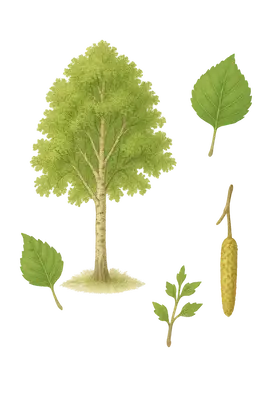Birch (Tree)
Description
Birch trees (Betula species) are slender, medium-sized deciduous trees belonging to the family Betulaceae. They are easily identified by their distinctive white or silver bark that often peels into thin, papery layers. Birch trees typically feature triangular or diamond-shaped leaves with serrated edges and produce abundant wind-dispersed pollen during spring. Common species include silver birch (Betula pendula) and downy birch (Betula pubescens) in Europe, and paper birch (Betula papyrifera) in North America. Birch pollen is among the most potent tree allergens and can travel long distances on the wind.

Allergy Symptoms
Birch pollen is highly allergenic and commonly causes:
- Sneezing and runny or congested nose
- Itchy, watery, and red eyes
- Coughing and throat irritation
- Wheezing and exacerbation of asthma symptoms
Birch pollen allergies frequently trigger Oral Allergy Syndrome (OAS), causing itching or tingling of the mouth and throat when consuming certain raw fruits, vegetables, and nuts. Common cross-reactive foods include apples, pears, cherries, peaches, plums, kiwi, carrots, celery, hazelnuts, and almonds. Cooking these foods typically reduces or eliminates the allergic reaction.
Typical Pollination Period
Birch trees typically pollinate from late March through May, with peak pollen release occurring in April across most temperate regions of the Northern Hemisphere. The timing varies by location: pollination begins earlier in warmer, southern climates and may extend later in colder, northern regions. Weather conditions such as temperature and rainfall significantly influence both the timing and intensity of the pollen season.
Geographic Distribution
Birch trees are widespread across the temperate and boreal zones of the Northern Hemisphere:
- Europe: Especially common throughout Northern, Central, and Eastern Europe, where birch is one of the most significant allergenic trees
- North America: Prevalent across Canada and the northern United States, particularly in the Northeast and Great Lakes regions
- Asia: Found extensively throughout Siberia, Northern China, Korea, and Japan
Tips for Reducing Exposure and Managing Allergies
- Monitor local pollen forecasts and limit outdoor activities during high pollen days
- Keep windows closed and use air purifiers with HEPA filters indoors
- Shower and change clothes after spending time outdoors
- Use antihistamines or nasal corticosteroids as recommended by a healthcare professional
- Be aware of cross-reactive foods if you experience Oral Allergy Syndrome
- Consider allergy testing and immunotherapy for persistent or severe symptoms